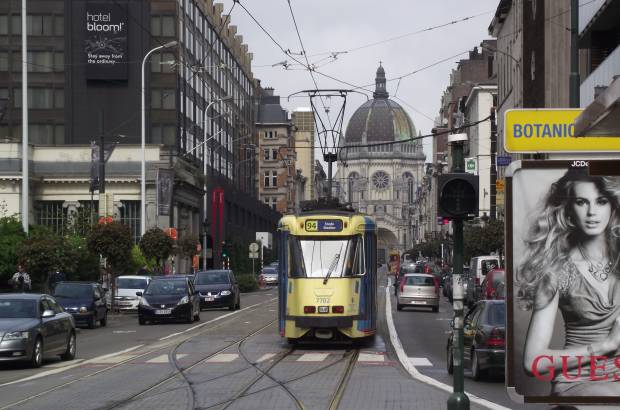- Daily & Weekly newsletters
- Buy & download The Bulletin
- Comment on our articles
Up my street: The Bulletin's neighbourhood guide to Saint-Josse
Tiny Saint-Josse is a vibrant, diverse place to live. At one-30th the size of next-door Brussels City, it’s both the smallest and most densely populated municipality in the country, with its 27,000 inhabitants sharing just over 1km2 of space. It’s home to the beautiful botanical gardens and Botanique cultural centre, as well as the Brussels institution jazz venue Jazz Station and a multicultural food scene. We asked readers of The Bulletin to tell us what they like about living there, and what they’d change.
“I live near Saint-Josse church and I’ve been told that this was a very different place a few years ago,” says Ricardo from Portugal, who’s previously lived in Libya, Spain and Germany and has been in Saint-Josse for a year. “Today, I wouldn’t say that this part of the neighbourhood is a nice place to roam around. But I like the proximity with Ambiorix and Square Marie-Louise, and the colour changes between the different seasons, and how easy it is to get here from the places where I usually go. What I miss the most is a nice cafe or terrace. I feel I always have to go somewhere else for that kind of thing. I am still looking for that one special thing.”
“Saint-Josse is cheap and colourful and vibrant, with lots of really good kebab and fruit and veg shops,” according to one Scottish resident. “But the areas north of Place Saint-Josse don’t feel safe and the traffic is horribly congested.” “It’s lively, with many families and children playing outside,” says one Polish resident. “The public transport and cleanliness could be improved, but I’ve found staff at the town hall extremely helpful.”
Frans from Limburg has lived here for 34 years and calls it “our little village with two faces. It’s very quiet in the evenings and at weekends, and we know all our neighbours. Every day I walk to work from Hamerstraat via Square Marie-Louise (with its park, pond and fountain), to Schuman and Oudergemlaan. It’s a nice route.” What would he like to change about life here? “I would prefer it to merge with Brussels City, because it’s too small. And for a Dutch-speaking person, going to any town hall in Brussels is a risk.”
An Italian expat who responded to our reader survey is happy to call Saint-Josse home after having lived here for five years. “There is cheap housing and grocery shopping, and it’s close to the city centre, parks and transport,” they told us. “It could be cleaner, and I’d like to meet more locals here. I’ve found staff at the town hall very fast and very helpful.” Indeed, somewhat unusually for Belgian authorities, the town hall is very active and responsive on Facebook, Twitter and Instagram, under the banner of ‘I Love Saint-Josse’, while sections of its website are available in English.
A report from 2017 shows that Saint-Josse has the lowest levels of car ownership in the country, with 181 cars per 1,000 inhabitants (for comparison, the highest level was in the Walloon Brabant town of Lasne, at 552 per 1,000 people). Despite this low density of cars, parking here can be difficult, and last year the commune’s roads hit the headlines when a series of sinkholes opened up. The municipality is well-served by public transport, though, and both the EU institutions and city centre are within easy reach on foot. Metro lines 2 and 6 mark the border between Saint-Josse and Brussels City, with the stops Rogier, Botanique and Madou all within the commune, and Arts-Loi – where lines 2 and 6 intersect with lines 1 and 5 – just outside its borders. North station is also close by, with the international hub of Midi a few stops away by metro. Buses and trams also link the area with the rest of the city.
Property here is reasonably priced, with one-bedroom apartments close to Botanique available to buy for €150,000, according to property website Immoweb. Two-bedroom flats to rent are priced at around €800 per month, though prices naturally increase closer to the EU quarter.
Favourite spots
Vieux Saint-Josse, a bar serving Belgian beers and crepes on Place Saint-Josse • Imperial Exotic Fruits speciality food shop • Snack Madou kebab shop, Rue des Deux Eglises • Botanical gardens • Le Palais des Delices Moroccan restaurant • Botanique for international and Belgian concerts and exhibitions • Théâtre le Public for dinner and French-language performances • Charlier Museum in a Victor Horta-designed mansion • Smoods bar and restaurant at Hotel Bloom • Théâtre de la Vie • Jazz Station • Shere E Punjab Indian restaurant • Les Dames Tartine French restaurant • Café Bota • Italian restaurants Dolce Tentazione, La Mamma and La Sardegna • La Belle Epoque bistro • Dilmon Lebanese restaurant
Positives
- Diverse, multicultural and lively
- Affordable property
- Good public transport
- Close to city centre and EU institutions
Negatives
- Noisy and crowded
- Traffic congestion and difficulty finding parking spots
- Some areas feel unsafe
















